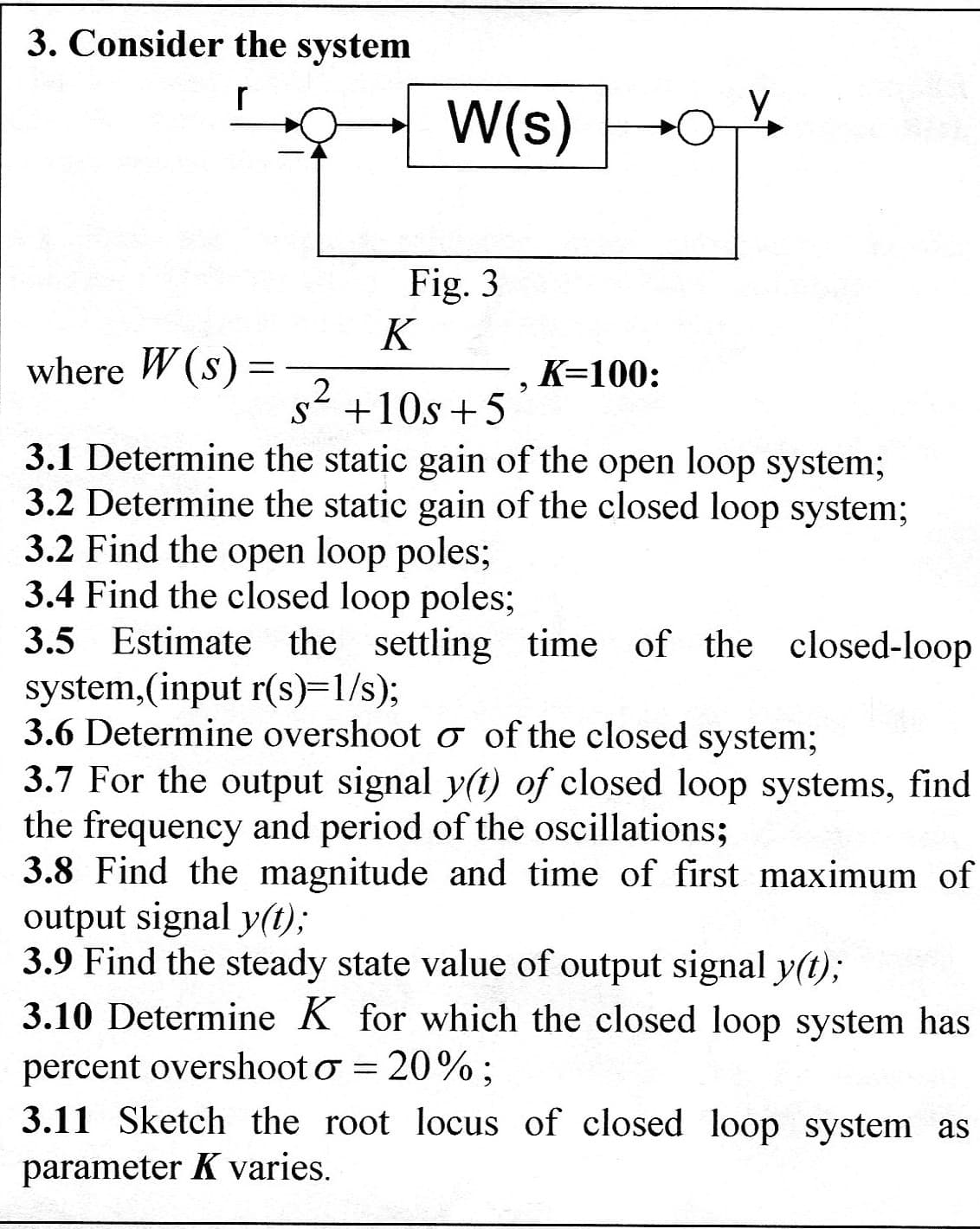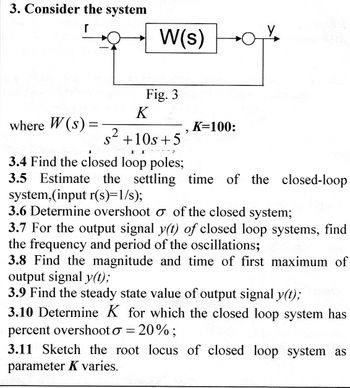3. Consider the system r where W(s) = = 2 W(s) S Fig. 3 K , K=100: +10s +5 3.1 Determine the static gain of the open loop system; 3.2 Determine the static gain of the closed loop system; 3.2 Find the open loop poles; 3.4 Find the closed loop poles; 3.5 Estimate the settling time of the closed-loop system, (input r(s)=1/s); 3.6 Determine overshoot o of the closed system; 3.7 For the output signal y(t) of closed loop systems, find the frequency and period of the oscillations; 3.8 Find the magnitude and time of first maximum of output signal y(t); 3.9 Find the steady state value of output signal y(t); 3.10 Determine K for which the closed loop system has percent overshoot o = 20%: 3.11 Sketch the root locus of closed loop system as parameter K varies.
3. Consider the system r where W(s) = = 2 W(s) S Fig. 3 K , K=100: +10s +5 3.1 Determine the static gain of the open loop system; 3.2 Determine the static gain of the closed loop system; 3.2 Find the open loop poles; 3.4 Find the closed loop poles; 3.5 Estimate the settling time of the closed-loop system, (input r(s)=1/s); 3.6 Determine overshoot o of the closed system; 3.7 For the output signal y(t) of closed loop systems, find the frequency and period of the oscillations; 3.8 Find the magnitude and time of first maximum of output signal y(t); 3.9 Find the steady state value of output signal y(t); 3.10 Determine K for which the closed loop system has percent overshoot o = 20%: 3.11 Sketch the root locus of closed loop system as parameter K varies.
Power System Analysis and Design (MindTap Course List)
6th Edition
ISBN:9781305632134
Author:J. Duncan Glover, Thomas Overbye, Mulukutla S. Sarma
Publisher:J. Duncan Glover, Thomas Overbye, Mulukutla S. Sarma
Chapter14: Power Distribution
Section: Chapter Questions
Problem 14.19P
Related questions
Question

Transcribed Image Text:3. Consider the system
r
where W(s) =
=
2
W(s)
S
Fig. 3
K
, K=100:
+10s +5
3.1 Determine the static gain of the open loop system;
3.2 Determine the static gain of the closed loop system;
3.2 Find the open loop poles;
3.4 Find the closed loop poles;
3.5 Estimate the settling time of the closed-loop
system, (input r(s)=1/s);
3.6 Determine overshoot o of the closed system;
3.7 For the output signal y(t) of closed loop systems, find
the frequency and period of the oscillations;
3.8 Find the magnitude and time of first maximum of
output signal y(t);
3.9 Find the steady state value of output signal y(t);
3.10 Determine K for which the closed loop system has
percent overshoot o = 20%:
3.11 Sketch the root locus of closed loop system as
parameter K varies.
Expert Solution
This question has been solved!
Explore an expertly crafted, step-by-step solution for a thorough understanding of key concepts.
Step by step
Solved in 5 steps with 4 images

Follow-up Questions
Read through expert solutions to related follow-up questions below.
Follow-up Question

Transcribed Image Text:3. Consider the system
r
where W(s)
=
W(s)
Fig. 3
K
2
s +10s +5
7
9
K=100:
3.4 Find the closed loop poles;
3.5 Estimate the settling time of the closed-loop
system,(input r(s)=1/s);
3.6 Determine overshoot o of the closed system;
3.7 For the output signal y(t) of closed loop systems, find
the frequency and period of the oscillations;
3.8 Find the magnitude and time of first maximum of
output signal y(t);
3.9 Find the steady state value of output signal y(t);
3.10 Determine K for which the closed loop system has
percent overshoot o = 20% ;
3.11 Sketch the root locus of closed loop system as
parameter K varies.
Solution
Knowledge Booster
Learn more about
Need a deep-dive on the concept behind this application? Look no further. Learn more about this topic, electrical-engineering and related others by exploring similar questions and additional content below.Recommended textbooks for you

Power System Analysis and Design (MindTap Course …
Electrical Engineering
ISBN:
9781305632134
Author:
J. Duncan Glover, Thomas Overbye, Mulukutla S. Sarma
Publisher:
Cengage Learning

Power System Analysis and Design (MindTap Course …
Electrical Engineering
ISBN:
9781305632134
Author:
J. Duncan Glover, Thomas Overbye, Mulukutla S. Sarma
Publisher:
Cengage Learning